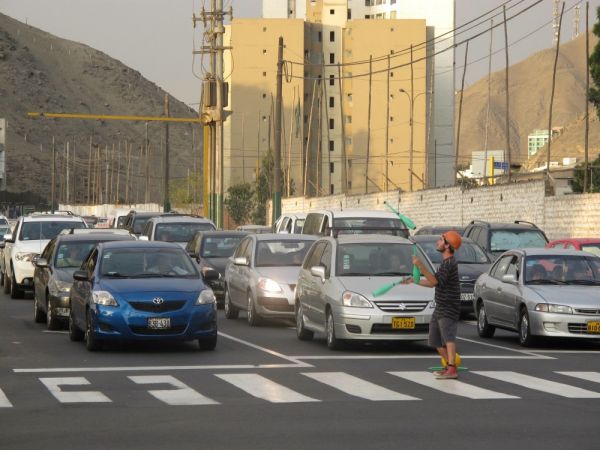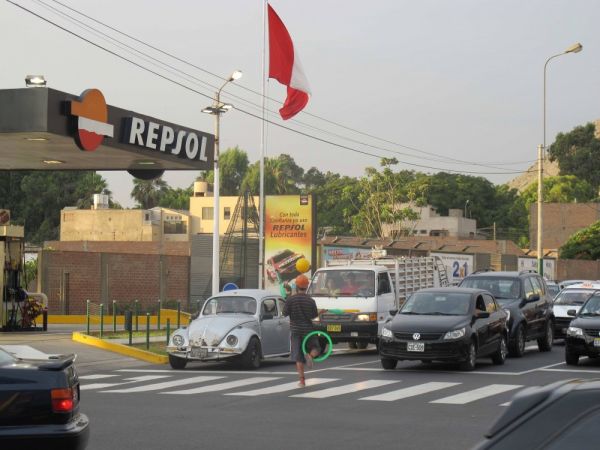Gridlock Creates a Captive Audience for Lima’s Street Performers

With traffic jams on the rise, the city’s street performers have found a new audience. Photo credit: Manuel Vigo
In a city where the average rush-hour driving speed is 11 kilometers per hour, the idea of the street as a simple conveyance for cars is almost quaint. Hawkers roam every intersection, selling everything from clothing to antiques. Red lights create impromptu bazaars where vendors sell sandwiches and offer to give your windshield a quick wash. And in recent years, a new group of informal workers has begun appearing in ever greater numbers amid the Peruvian capital’s epic traffic jams: juggling, breakdancing and stilt-walking street performers.
“Good evening everyone! How are you tonight?” shouts Cristian with a strong voice and wide smile at a sea of gridlocked cars before launching into a juggling routine fit for Barnum and Bailey.
A 23-year-old college dropout from northern Peru who came to Lima a little over a year ago to find work, Cristian’s place of employment is a four-way intersection in Surco, one of the city’s more affluent neighborhoods. “I was in college and wasn’t very into classes, and I wanted something else I could work in,” he says. “I sort of fell into the circus world. I quit college and started walking on stilts. I trained and trained and then went off to the streets.” He applied and was accepted to a circus and performing arts academy in Lima.
As soon as the traffic light turns red, Cristian walks into the crossing and begins juggling his clubs, flashing them from one hand to the other, sometimes spinning in place while they’re all in the air. His signature move is letting a club fall towards the ground before kicking it back up into the air with his foot. “I don’t even need to count in my head anymore,” he says of timing the traffic lights while keeping his eyes on the clubs. His performance is as choreographed as a circus act, efficient enough to leave him time to dash from car to car to receive money from drivers who spend an average of two to three hours stuck in traffic every day.
A young performer fits multiple acts into the space of one red light. Video by Bahador Alast via YouTube.
But like many informal sector jobs, street performing is becoming a tougher gig in Lima. City officials have begun cracking down, forcing performers away from busy intersections. “Some of them are polite, others are not,” says Cristian of the law enforcement officials. “Some tell me they are just doing their job, and I understand.”
The recent increase in street performers has also created competition for space. Some monopolize certain intersections. “But there is sort of an international rule,” he says. “If you arrive at a traffic light and there are two performers already on there, you have to go somewhere else. If there is one, you can ask him, and if he wants, you can share the street, but you also have to share what you make.”
Though street performers can make between 50 to 60 soles per hour ($19 to $23 USD) on good days, Cristian says the scene used to be more lucrative. Seven years ago, when he began performing, it wasn’t uncommon for a juggler to make 200 soles an hour (about $78 USD), an impressive figure in a country where the minimum monthly wage is about $334.
“I’ve been in Lima for over a year, living only off the street lights, and now I’ve started doing stuff at private events,” he says. He would also like to be part of a formal group of street performers, and says he has seen some improvements, but not enough.
“There are people who are already working formally, and they’re sending proposals to different districts.” In these cases the district organizes juggling workshops in public parks, as part of cultural and artistic programs aimed at children, and in theory gives street performers a chance of having a fixed income.

The increasing numbers of performers on Lima’s streets is making the gig less lucrative for everyone, say some of them. Photo credit: Manuel Vigo
But Cristian wary of linking his employment with the formal sector – he’s seen friends cut deals with the city, only to find themselves going for months without receiving a paycheck, and when they do, it’s only half of what was originally agreed upon.
However other initiatives have been more successful in giving street performers access to the formal world. Angeles D1, a project heralded by Vania Masias, a prominent Peruvian ballet dancer, is working toward integrating young street performers and at-risk youth with the formal world. The organization hopes to get children who perform in the street back into classrooms, while still giving them an opportunity to generate their own income by becoming part of professional dance troupes.
For his part, Cristian has big dreams for his career, and wants to sell one of his routines to a circus, where a performer can make good money. “Maybe one day also set up my own school,” he says. But for now, he says he is content making a living off of the street and supplementing that income with the occasional private event.
“On the streets money comes directly to you, but you have to fight for it,” he says. “You have to fight when you are kicked out, fight against people who don’t have time or money for you, and fight against the sun every morning.”









